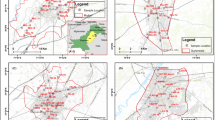Abstract
We assessed the potential of fluoride (F) contamination in drinking groundwater of an intensively cultivated district in India as a function of its lithology and agricultural activities. Three hundred and eight groundwater samples were collected at different depths from various types of wells and analyzed for pH, EC, NO3–N load and F content. A typical litholog was constructed and database on fertilizer and pesticide uses were also recorded for the district. The water samples were almost neutral in reaction and non-saline in nature with low NO3–N content (0.02 to 4.56 μg mL−1). Fluoride content in water was also low (0.01 to 1.18 μg mL−1) with only 2.27% of them exceeding 1.0 μg mL−1 posing a potential threat of fluorosis. On average, its content varied little spatially and along depth of sampling aquifers because of homogeneity in lithology of the district. The F content in these samples showed a significant positive correlation (r=0.12, P= ≤0.05) with the amount of phosphatic fertilizer (single super phosphate) used for agriculture but no such relation either with the anthropogenic activities of pesticide use or NO3–N content, pH and EC values of the samples was found. The results suggest that the use of phosphatic fertilizer may have some role to play in F enrichment of groundwater.
Similar content being viewed by others
References
Anonymous (2006). Annual Report (2006), Department of Agriculture, Government of West Bengal, Writers’ Buildings, Kolkata. pp. 174.
Crosby, N. T., Dennis, A. L., & Stevens, J. G. (1968). An evaluation of some methods for the determination of fluoride in potable waters and other aqueous solutions. Analyst, 93, 643–652.
EPA (1997). Public health global for fluoride in drinking water. Pesticide and environmental toxicology. Section Office of Environmental Health Hazard Assessment, California Environmental Protection Agency.
Gupta, S., Banerjee, S., Saha, R., Datta, J. K., & Mondal, N. (2006). Fluoride geochemistry of groundwater in Birbhum, West Bengal, India. Fluoride, 39, 318–320.
Kar, S., Khan, D. K., & Santra, S. C. (2003). Status of nitrate concentration in groundwater: a case study in Nadia district, West Bengal, India. Science Culture, 69, 379–382.
Kundu, M. C. (2007). Studies on nitrate loading in groundwater due to intensive cultivation in Hooghly district of West Bengal. Ph.D. Thesis, Bidhan Chandra Krishi Viswavidyalaya, West Bengal, India. pp. 166.
Kundu, M. C., Mandal, Biswapati & Sarkar, D. (2007). Assessment of the potential hazards of nitrate contamination in surface and groundwater in a heavily fertilized and intensively cultivated district of India. Environmental Monitoring and Assessment, DOI 10.1007/s10661-007-0070-z.
Mukhopadhyay, A. K., Ghosh, S. K., & Trivedi, N. (2004). Soil fertility status of West Bengal (p. 135). Kolkata: Indian Farmers Fertilizer Cooperative Ltd.
PHED (2007). A note on fluoride contamination of ground water in West Bengal. Public Health Engineering Department. Govt. of West Bengal, Kolkata. Available at www.wbphed. gov.in/flroride_cont.html
Ramanaiah, S. V., Venkatamohan, S., Rajkumar, B., & Sarma, P. N. (2006). Monitoring of fluoride concentration in groundwater of Prakasham district in India: correlation with physico-chemical parameters. Journal of Environmental Science and Engineering, 48, 129–134.
Suthar, S., Garg, V. K., Jangir, S., Kaur, S., Goswami, N. & Singh, S. (2007). Fluoride contamination in drinking water in rural habitations of northern Rajasthan, India. Environmental Monitoring and Assessment. DOI 10.1007/ s10661-007-0011-x.
UNICEF (1999). States of the art report on the extent of fluoride in drinking water and the resulting endemicity in India. Report by Fluorosis and Rural Development Foundation for UNICEF, New Delhi.
USEPA (1979). Methods for chemical analysis of water and wastes. Washington, D.C.: United States Environmental Protection Agency.
WHO (1997). Guidelines for drinking-water quality, 2nd ed. Vol. 3. Surveillance and control of community supplies. Geneva, World Health Organization. Available at http://www.who.int/water_sanitation_health/ dwq/guidelines4/en/
WHO (2006). Fluoride in drinking water (p. 144). London: IWA publishing.
Author information
Authors and Affiliations
Corresponding author
Rights and permissions
About this article
Cite this article
Kundu, M.C., Mandal, B. Assessment of potential hazards of fluoride contamination in drinking groundwater of an intensively cultivated district in West Bengal, India. Environ Monit Assess 152, 97–103 (2009). https://doi.org/10.1007/s10661-008-0299-1
Received:
Accepted:
Published:
Issue Date:
DOI: https://doi.org/10.1007/s10661-008-0299-1




